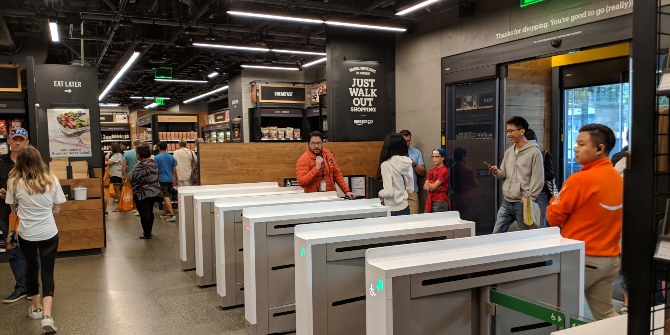Despite the quick pace of changes AI is producing in the workplace, many leaders are still not considering how things might soon be done very differently. ‘Present bias’ keeps them from leveraging new technologies to make the workplace more productive and inclusive. Yolanda Blavo, Grace Lordan and Jasmine Virhia suggest key actions for leaders who want to set themselves up for success over the next decade of workplace transitions.
The speed at which artificial intelligence (AI) is shaping the work we do has greatly accelerated in recent months. Since January 2023, AI tools such as Chat GPT have been incorporated into the workplace for numerous tasks including data analysis, problem-solving, email management, marketing content generation, and even decision-making.
Given these changes, leaders need to consider how they can best support employees without the limitations of the current workplace. In a recent large qualitative study involving 100 diverse voices, we explored what this support might look like and what employees across all stages of their career cycle were predicting for the future of work. Participants were all professional workers and were currently employed in a large selection of financial and professional services companies, including HSBC, Citi, Barclays, JPMorgan, Santander, Deloitte and Natwest.
The fieldwork for this study took place between the spring and summer of 2022, before the most recent shift in artificial intelligence. Strikingly, participants (with the exception of three out of 100 voices) focused on the reorganisation of work influenced by the pandemic only. They did not mention AI and what new technologies may mean for the nature of the work we do. Primarily, the participants described the ongoing tension between some employers requiring employees to return to working in the office and employees desiring to maintain flexibility, emphasising the benefits of autonomy. Other dominant themes were the importance of psychological safety and trust in supporting the productivity of workers.
So why did those we interviewed choose to avoid naval gazing to visualise a longer-run future of work complemented by AI? We suspect naval gazing is owed to present bias: the tendency to be so fixated on what is occurring now that it distracts us from considering how things may differ in the future, even when those changes are right around the corner. Circumventing this tendency for present bias will enable leaders to smooth the transitions owed to AI in the workplace, as well as leverage these new technologies to make the workplace more productive and inclusive.
Below, we provide some actions we think leaders should take to set them up for success over the next decade of transitions in the workplace.
1. Leverage the benefits of technological advances for inclusion
To enhance inclusion, leaders should avoid working in isolation within their given firm, and instead, work with other leaders across their sector and beyond to set professional standards about how to harness the power of AI responsibly. Governance of AI will be critical to monitor conduct, and it will need to be based on trust instead of being rooted in fear of the unknown effects of integrating AI into the workplace.
We propose that leaders should consider how inclusion can be supported with advances in technology, such as the metaverse. The Metaverse allows people to interact with each other in real-time whilst immersing themselves in a virtual reality environment. In the Metaverse people are represented as avatars and people are able to connect with other people in the same virtual campus without being limited by geographic region. This can support social cohesion. For example, it can connect people who ordinarily would not be connected, which could potentially enable more people to bond and form meaningful relationships. In the metaverse, languages can be translated instantly making it a lot easier to have conversations with people from all over the world.
The metaverse may have implications for inclusion because it can allow employees to tailor their virtual workplace to their needs. It has assistive technology features that allow people with different abilities to change the interface. One could tailor the environment to their needs and shape how information in presented. If someone has challenges with reading black text it could be made purple for example.
2. Identify the key areas of the business where jobs can be automated with technology
AI has already replaced routine jobs such as those in the manufacturing industry. In the future we expect AI to continue to be even more disruptive to the job market, replacing many knowledge workers and even be able to do more creative tasks. There are new iterations of Chat GPT that will come out this year that will have the ability to use old ideas to create something innovative. After all, what is creativity, but joining together old ideas to form a new one? Thus, workers will need to identify their comparative advantage, beyond knowledge to set their abilities apart from AI.
To prepare for the future, leaders will need to learn to automate certain tasks so they can focus more of their efforts on aspects of the job that cannot be automated, such as repetitive data entry and analysis tasks. It can help make firms more efficient and allow leaders to focus more on other areas of the business that are more human-centered such as client relations and customer service.
3. Use AI to find new colleagues, as well as grow and promote them
Leaders may consider incorporating AI in the hiring process. Research supports that AI can make equivalent or better, less biased hiring decisions than humans acting independently. To determine the effectiveness of hiring decisions made by AI leaders, they can employ the HIRE framework, which is an acronym consisting of the elements to consider when comparing the quality of decisions made by AI compared to humans.
H- Humans provide the basis for comparison to AI decisions
I- (Artificial) Intelligence refers to algorithms that automate hiring decisions using pre-hiring and post-hiring data
R-Recruitment– the assessment of how AI is used throughout the recruitment process including CV and interview evaluation and other related aspects of recruitment that may influence the hiring decision.
E-Evaluation- the stage in which decisions made by AI vs. humans are rated as better, worse, or unclear.
Using this framework can allow leaders to make more informed hiring decisions.
Beyond hiring, AI can be used to provide transparency to employees in order to see what data is being used to make promotion and compensation decisions. This could allow them to see clearly what criteria was considered and can provide employees with a better sense of how their work is being assessed. The incorporation of AI in these decisions can potentially help to reduce bias because decisions would be made based on objective criteria as opposed to certain employees being favoured over others because they have an affinity with the hiring manager. AI can still be biased, therefore humans must monitor algorithms to ensure that employees are not being put at a disadvantage. For example, an employee returning from maternity leave may be overlooked for promotion if the decision is made solely using AI. Thus, humans will still have a role to play in supporting the employee growth cycle.
4. Address concerns surrounding the integration of AI in the workplace.
There is an increase in the automation of jobs, which has sparked fear around AI replacing humans in the workforce. Recently, leaders of OpenAI, Google DeepMind, and Anthropic were amongst 350 signatories of an open letter acknowledging that AI may pose considerable threats to humanity, including the widescale spread of misinformation and the elimination of millions of white-collar jobs. Thus, firms should also commit to minimising risks associated with AI. Leaders must stay up to date with developments in AI, establishing best practices across industries for the benefit of businesses and employees alike.
Further, socially responsible employers will ensure that their employees are allowed to stay in a new role with new skills. New research has found that jobs that require physicality (for instance, equipment maintenance) are likely to be replaced by automation, whereas jobs that require a lot of human interaction and require more abstract thinking are less likely to be automated (for example, managers, teachers, carers, and medical practitioners). These findings imply that it is worthwhile for firms to invest in developing their employees’ soft skills, such as critical thinking, communication, empathy, leadership, etc.
5. Beyond AI
Although we have provided numerous tasks that can be automated or will be in the future, one thing that AI cannot replace is human interaction. AI can mimic and engage in emotive communication to a certain extent, but it is lacking in terms of authentic body language, facial expressions, and emotions, which are necessary for fostering human connection. There will be a need for an inclusive leader to address “people” related issues in the future.
For example, leaders of the future will still need to create an environment that supports employees’ ability to be their authentic selves at work. As of 2022, approximately 5 per cent of young adults in the US identify as a gender that is different from their sex assigned at birth. Additionally, as of 2021, an estimated 1.2 million adults identify as nonbinary in the U.S. This emphasises the need for leaders to address employees using appropriate pronouns and to share their own pronouns in interactions, such as in meetings and emails.
While using appropriate language is a good starting point, there is still more that employers must do to create a truly inclusive environment. This could include providing gender-neutral bathrooms, having affinity group members and their allies discuss ways in which issues with organisational culture can be addressed, and also highlighting visible role models. Doing so can support employees’ ability to be their authentic selves at work, which can also improve work engagement and performance.
Key message: A present-day lens can limit a leader’s ability to adapt to an ever-evolving workplace. Therefore, leaders must anticipate more extensive large-scale changes to the workplace beyond the most salient recent changes and consider how to equip employees to work alongside as opposed to against AI. Here we provide five key ways in which leaders can do just that.
- This blog post represents the views of its authors, not the position of LSE Business Review or the London School of Economics.
- Featured image provided by Shutterstock
- When you leave a comment, you’re agreeing to our Comment Policy.





